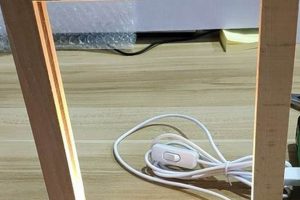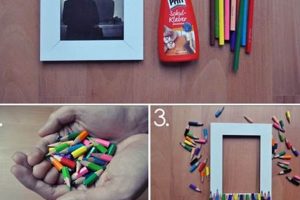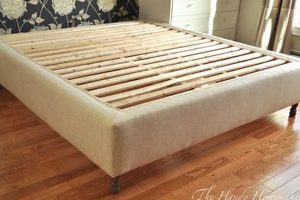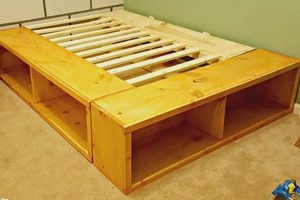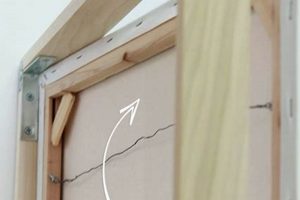The creation of picture holders from repurposed paper-based material represents an accessible and cost-effective method for displaying photographs. This craft project involves utilizing discarded corrugated fiberboard to construct personalized enclosures for treasured images. The resultant product offers a tangible and visually appealing means of showcasing memories.
This practice yields several advantages, including resource conservation through upcycling and the potential for significant cost savings compared to purchasing commercially manufactured frames. Historically, individuals have employed readily available materials for functional and decorative purposes; this method extends that tradition to modern photo presentation. It encourages creativity and provides a unique, personalized touch to home dcor.
Further discussion will explore various construction techniques, design considerations, and finishing methods to enhance the aesthetic appeal and structural integrity of these handmade displays. Emphasis will be placed on achieving professional-looking results with minimal cost and environmental impact. Subsequent sections will also address suitable adhesives, cutting tools, and decorative embellishments for these projects.
Crafting Superior Picture Mounts From Recycled Fiberboard
The following guidelines aim to elevate the quality and durability of enclosures crafted from reclaimed paperboard, ensuring optimal presentation and longevity of displayed images.
Tip 1: Material Selection: Employ thicker, multi-layered corrugated board for enhanced structural integrity. Discarded packaging from appliances or furniture frequently offers suitable material. Prioritize boards free from excessive creases or damage.
Tip 2: Precise Cutting: Utilize a sharp utility knife or specialized cutting tool designed for board. Employ a metal ruler as a guide to ensure straight, clean cuts. Multiple light passes are preferable to a single deep cut, minimizing the risk of tearing or warping the material.
Tip 3: Adhesive Application: Opt for pH-neutral, archival-quality adhesives to prevent degradation of both the mount and the photograph over time. Apply adhesive sparingly and evenly to avoid warping or bubbling of the paperboard.
Tip 4: Reinforcement Techniques: Strengthen corners and joints with additional strips of paperboard or fabric tape. These reinforcements enhance the overall stability and prevent separation under stress.
Tip 5: Surface Preparation: Prior to decoration, lightly sand the surface of the board to remove any rough edges or imperfections. This provides a smoother surface for paint, paper, or other decorative elements.
Tip 6: Decorative Considerations: When applying paint or coatings, use multiple thin layers rather than a single thick layer to prevent warping or uneven coverage. Allow each layer to dry completely before applying the next.
Tip 7: Backing and Support: Incorporate a sturdy backing panel to protect the photograph from dust and damage. Attach a hanging mechanism securely to the back of the frame, ensuring it is capable of supporting the weight of the assembled piece.
Implementing these strategies will result in picture mounts that are not only aesthetically pleasing but also robust and capable of safeguarding valuable photographic prints for years to come.
The subsequent section will delve into advanced decorative techniques and explore innovative uses for these repurposed creations beyond simple photo display.
1. Material Grade
The material grade of the repurposed paperboard directly influences the structural integrity and aesthetic quality of the resulting picture holder. Higher-grade corrugated fiberboard, characterized by thicker plies and denser construction, provides increased rigidity and resistance to bending or warping. This is particularly crucial for larger picture holders or those intended to display heavier images. Utilizing substandard material, such as thin or damaged cardboard, can lead to a flimsy frame that is prone to collapse or distortion under load. For instance, using a single layer corrugated box for a large frame may result in sagging over time. The grade selected impacts both the functionality and longevity of the final product.
Furthermore, material quality affects the ease of cutting and finishing. Denser boards allow for cleaner, more precise cuts, contributing to a professional appearance. They also provide a more receptive surface for adhesives and decorative finishes. Conversely, low-grade boards may splinter or tear during cutting, and their porous surface can absorb excessive amounts of paint or glue, leading to uneven application and a compromised final result. Selecting the proper cardboard involves careful assessment of its thickness, density, and overall condition to ensure suitability for the intended application.
In conclusion, material grade is not merely a superficial consideration but a fundamental determinant of the success of any picture holder project. Choosing an appropriate grade ensures structural stability, facilitates ease of construction, and contributes significantly to the overall aesthetic appeal of the finished display. Disregard for material quality can lead to a compromised end product, undermining both the visual presentation and the long-term durability of the repurposed creation.
2. Cutting Precision
In the context of constructing picture mounts from reclaimed paperboard, cutting precision directly determines the dimensional accuracy and structural integrity of the final product. Accurate cuts ensure that the frame components fit together seamlessly, creating tight, secure joints. Poorly executed cuts, characterized by uneven edges or incorrect angles, result in gaps, instability, and an overall unprofessional appearance. For example, if the mitered corners of a rectangular frame are not cut at precisely 45-degree angles, the resulting frame will be non-square and visually unappealing. The importance of cutting accuracy cannot be overstated; it is a foundational element influencing the aesthetic quality and the long-term durability of the project.
The application of precise cutting techniques extends beyond basic dimensional accuracy. Intricate designs or decorative elements, such as beveled edges or complex geometric patterns, require a high degree of precision to execute effectively. Using a sharp blade, a metal ruler as a guide, and employing multiple light passes rather than forcing a single deep cut minimizes the risk of tearing or warping the paperboard. Furthermore, specialized cutting tools, such as craft knives or rotary cutters, can enhance accuracy and efficiency, particularly when working with thicker or more resistant materials. The selection of appropriate tools and techniques is crucial for achieving consistently precise cuts and maintaining the structural integrity of the picture mount.
In summary, cutting precision is a critical determinant of the success of picture mounts crafted from reclaimed paperboard. It impacts both the aesthetic appearance and the structural stability of the finished product. Achieving precise cuts requires attention to detail, the use of appropriate tools, and adherence to proper cutting techniques. Neglecting cutting accuracy can compromise the overall quality and longevity of the frame, undermining the effort invested in its construction. Mastering cutting precision is essential for anyone seeking to create professional-looking and durable picture mounts from repurposed materials.
3. Adhesive Strength
Adhesive strength is a critical determinant of the structural integrity and longevity of picture holders constructed from repurposed paperboard. Insufficient adhesive strength results in component separation, rendering the frame structurally unsound and compromising its ability to securely hold and display the photograph. For example, using standard office glue stick on load-bearing joints typically leads to failure over time, especially in environments with fluctuating temperature and humidity. This highlights the cause-and-effect relationship where the choice of adhesive directly impacts the durability of the assembly. The selection of appropriate adhesive is thus not merely a matter of convenience but a fundamental factor in the successful fabrication of a functional and enduring picture holder.
The adhesive must possess sufficient shear strength to withstand the forces acting on the joined surfaces, particularly at corners and points of stress. Depending on the overall dimensions and the weight of the photo, appropriate adhesive types may include polyvinyl acetate (PVA) glues, hot melt adhesives, or specialized archival-quality adhesives. PVA glues provide a strong, permanent bond and are suitable for most applications. Hot melt adhesives offer rapid setting times but may not provide the same level of long-term durability. Archival adhesives are specifically formulated to be pH-neutral and acid-free, preventing degradation of both the paperboard and the photograph over extended periods. The decision depends on both project needs and preservation goals. The structural integrity also depends on the surface preparation.
In summary, adhesive strength constitutes a vital, often underestimated aspect of picture holder construction from reclaimed paperboard. Selecting an adhesive that is appropriate for the specific materials and load-bearing requirements is essential for creating a durable and aesthetically pleasing display. Failing to prioritize adhesive strength can lead to premature failure of the assembly, undermining the overall purpose of the repurposed creation. Challenges include balancing adhesive strength with material compatibility and archival considerations, which are resolved through thorough adhesive selection and proper application techniques.
4. Structural Support
Structural support is a paramount consideration in the construction of picture holders from reclaimed paperboard. The capacity of the holder to maintain its form and adequately bear the weight of the enclosed photograph is directly contingent upon the design and implementation of effective structural elements. Without adequate support, the frame is susceptible to bending, warping, or complete collapse, rendering it functionally useless and aesthetically unappealing. For instance, a large, thin paperboard frame lacking internal bracing will likely sag under the weight of a photograph, distorting the image and potentially damaging the frame itself. This underscores the cause-and-effect relationship: insufficient structural integrity leads to predictable failure.
The implementation of structural support involves several techniques. Reinforcing corners with additional layers of paperboard or rigid materials, such as wood or metal brackets, significantly enhances stability. Employing a backing board of sufficient thickness and rigidity provides a solid foundation for the photograph and prevents the frame from twisting or bending. Internal bracing, consisting of strategically placed strips of paperboard or other materials, distributes the load and prevents localized stress concentrations. The specific methods chosen depend on the size and weight of the photograph, the properties of the paperboard, and the desired aesthetic. For example, larger frames may require more extensive bracing and corner reinforcement than smaller, lighter frames. Practical application involves careful assessment of these factors to determine the appropriate level of structural support.
In conclusion, structural support is not merely an ancillary detail but a fundamental prerequisite for the successful construction of picture holders from reclaimed paperboard. Adequate support ensures the frame’s stability, longevity, and ability to effectively showcase the enclosed photograph. Neglecting structural considerations inevitably leads to a compromised end product that is both visually unappealing and functionally deficient. Overcoming these challenges requires thoughtful design, careful material selection, and precise execution of reinforcement techniques, linking back to the broader goal of repurposing materials to create sustainable and aesthetically pleasing display solutions.
5. Surface Finish
The surface finish of a repurposed fiberboard photo frame directly influences its aesthetic appeal and perceived value. An unfinished or poorly finished frame detracts from the photograph it is intended to showcase, while a well-executed surface treatment enhances the overall presentation. For example, a frame constructed from recycled cardboard with visible creases, uneven edges, and exposed corrugated fluting presents a markedly different impression compared to one that has been sanded smooth, primed, and painted with a consistent, durable finish. The cause-and-effect relationship is evident: the quality of the surface finish directly impacts the perceived quality and value of the frame. The finish serves as a crucial component of the frame, contributing significantly to its visual impact and tactile experience.
Practical considerations for achieving a satisfactory surface finish on paperboard frames include sanding to remove imperfections, applying a primer to create a uniform base for subsequent coatings, and selecting appropriate paints or other decorative treatments. Water-based acrylic paints are often preferred due to their ease of application, low odor, and durability. Techniques such as applying multiple thin coats and using sealants can further enhance the longevity and resistance to wear and tear. The specific methods employed depend on the desired aesthetic and the intended use of the frame. For instance, a frame designed for a child’s room might benefit from a brightly colored, durable finish, while a frame intended for a formal setting might require a more subdued and sophisticated treatment. A surface of consistent finish quality can also help mitigate problems with the board material, such as differences in color across its body.
In summary, surface finish is a critical attribute of frames made of recycled cardboard. Prioritizing this aspect elevates the frame’s aesthetic appeal and enhances its durability. Challenges inherent in achieving a smooth, professional finish on paperboard include dealing with the material’s inherent texture and porosity, addressed with techniques such as sanding, priming and applying multiple coats of paint. Achieving a quality surface finish transforms discarded cardboard into valuable and aesthetically pleasing photo displays.
6. Design Aesthetic
The design aesthetic of repurposed paperboard picture frames directly influences their perceived value and suitability for specific environments. The aesthetic choices, ranging from minimalist utilitarianism to elaborate ornamentation, dictate the frame’s visual impact and its capacity to complement or contrast with the enclosed photograph and surrounding dcor. A poorly considered design aesthetic undermines the potential of the frame, whereas a well-executed design enhances both the visual appeal of the photograph and the overall ambiance of the space. For instance, a rustic-themed photograph might be appropriately displayed in a frame constructed from deliberately distressed cardboard, while a modern, minimalist photograph would benefit from a clean, unadorned frame design. This illustrates the cause-and-effect relationship between design choices and the resulting aesthetic impact. The aesthetic style represents a fundamental component dictating its function as a display object.
Practical applications of understanding design aesthetic in the context of paperboard frames include tailoring the frame’s appearance to the style of the photograph, the existing dcor, or the personal preferences of the recipient. Techniques such as applying decorative papers, painting with specific color palettes, or adding embellishments like beads, buttons, or fabric scraps can be employed to achieve a desired aesthetic. The design can range from a stark minimalist approach to one that heavily emphasizes surface texture and ornamentation. Furthermore, the design aesthetic influences the choice of materials and construction methods. A minimalist design might prioritize clean lines and simple joinery, while an ornate design might necessitate more complex cutting and assembly techniques. This can also be incorporated into commercial operations like for example framing a restaurant’s menus and daily specials, and framing art pieces for low budget art shows.
In conclusion, design aesthetic forms an integral component in repurposing cardboard for picture frames, shaping the overall appeal and influencing how it is received. Challenges include balancing creative expression with the constraints of the material and ensuring that the frame effectively complements the displayed photograph. By thoughtfully considering the design aesthetic, discarded paperboard can be transformed into unique, personalized, and visually appealing display solutions, furthering the possibilities for upcycling these materials.
7. Image Protection
The preservation of displayed images constitutes a primary concern when utilizing self-constructed picture mounts from repurposed fiberboard. The materials and construction methods employed directly influence the long-term integrity of the photograph. Inadequate protection can lead to irreversible damage, negating the purpose of the display.
- Acid Migration Prevention
Non-archival paperboard contains acids that migrate to the photograph over time, causing discoloration and embrittlement. Employing acid-free backing materials and adhesive barriers mitigates this risk. For example, lining the interior of the frame with archival-quality paper creates a protective buffer, preventing direct contact between the photograph and the potentially damaging cardboard.
- UV Light Filtration
Prolonged exposure to ultraviolet (UV) light causes fading and degradation of photographic prints. Incorporating UV-filtering glazing, such as acrylic sheets, significantly reduces the amount of harmful radiation reaching the image. A simple application would be applying a UV-protecting film to the acrylic.
- Physical Barrier Against Dust and Debris
Open-backed frames allow dust, dirt, and insects to accumulate on the surface of the photograph, leading to scratches and discoloration. Enclosing the image within a sealed environment, using a backing board and glazing, provides a physical barrier against these contaminants. For instance, a tightly sealed frame prevents dust accumulation, preserving the photograph’s clarity and contrast.
- Humidity Control
Fluctuations in humidity can cause warping, mold growth, and other forms of damage to photographic prints. Maintaining a stable humidity level within the frame minimizes these risks. Using a well-sealed frame and avoiding placement in areas with high humidity, such as bathrooms, helps regulate moisture levels.
These protective measures, when integrated into the creation of paperboard picture frames, effectively safeguard photographic prints from environmental damage, ensuring their longevity. Disregarding these considerations jeopardizes the preservation of valuable images, highlighting the importance of informed construction techniques.
Frequently Asked Questions
The following elucidates common inquiries concerning the fabrication and utilization of picture displays crafted from recycled fiberboard, offering comprehensive answers to ensure optimal construction and preservation of displayed photographs.
Question 1: What type of paperboard is most suitable for constructing picture holders?
Multi-layered corrugated fiberboard offers enhanced structural integrity compared to single-layer options. Thicker boards are preferable for larger frames or those intended to support heavier images. Prioritize material free from excessive creases or damage.
Question 2: What adhesive type is recommended for joining paperboard components?
pH-neutral, archival-quality adhesives are advisable to prevent degradation of both the mount and the photograph over time. Polyvinyl acetate (PVA) glues offer a strong, permanent bond suitable for most applications. Apply adhesive sparingly and evenly.
Question 3: How can the structural integrity of the picture holder be reinforced?
Reinforce corners and joints with additional strips of paperboard or fabric tape. Employing a sturdy backing panel provides support and protects the photograph. Internal bracing distributes the load and prevents localized stress concentrations.
Question 4: What steps should be taken to ensure a smooth surface finish?
Lightly sand the surface of the board to remove rough edges or imperfections. Apply a primer to create a uniform base for paint or other decorative elements. Apply multiple thin layers of paint or coating rather than a single thick layer.
Question 5: How can photographic prints be protected from damage within the paperboard frame?
Utilize acid-free backing materials to prevent acid migration from the paperboard to the photograph. Incorporate UV-filtering glazing to protect against fading and degradation. Ensure the frame is sealed to prevent dust and insect infiltration.
Question 6: Are picture holders from reclaimed paperboard suitable for long-term archival display?
With careful material selection, proper construction techniques, and implementation of protective measures, repurposed paperboard frames can provide adequate protection for photographic prints intended for long-term display. Regular inspection and maintenance are recommended.
Proper material selection, construction techniques, and protective measures contribute to robust frames. The frame design influences the longevity and stability. These elements contribute to a lasting means of displaying treasured photos.
The succeeding section explores advanced decorative techniques and innovative applications for these repurposed constructions beyond simple photo display.
Conclusion
The preceding exploration of photo frame diy cardboard projects has illuminated the intersection of resourcefulness, creativity, and archival considerations. Key points have encompassed material selection for structural integrity, precision cutting for dimensional accuracy, appropriate adhesive usage for long-term bonding, reinforcement strategies, surface finish techniques, design aesthetic influences, and vital image protection measures. Each element contributes significantly to the final product’s viability as a durable and visually appealing display solution.
The act of crafting picture frames from repurposed corrugated fiberboard represents more than a mere craft project; it signifies a commitment to sustainable practices and personalized expression. By embracing these techniques, individuals can transform discarded materials into treasured objects, safeguarding precious memories while simultaneously reducing environmental impact. Continued innovation in design and material selection promises further enhancement of both the aesthetic qualities and archival capabilities of photo frame diy cardboard creations.


